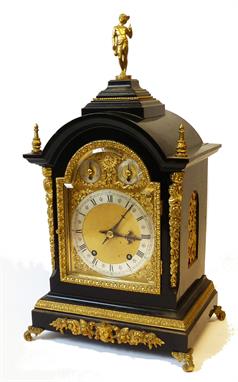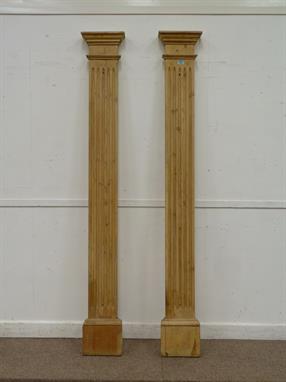We found 35023 price guide item(s) matching your search
There are 35023 lots that match your search criteria. Subscribe now to get instant access to the full price guide service.
Click here to subscribe- List
- Grid
-
35023 item(s)/page
A Rare French Empire Cast Iron Fontaine de Cygne, early 19th c., probably Lyon, incurvate swan neck fountain head over a shell-form tazza, on a spiral column with acanthine and C-scroll foliate capital and molded base, height 46 1/2 in. Note: This fountain was inspired by the public fountains Napoleon I erected in Paris following his return from the Egyptian campaigns. One of the earliest fountains was the "Fontaine de Léda"- a bas relief stone plaque from which a swan`s neck protruded to form the water spigot. Two successive fountains, the "Fontaine du Palais des Arts" and "Chateau d`eau du boulevard Bondi", were largely made of cast-iron. Both fountains combined Neoclassical elements with stylized lions (influenced by Egyptian iconography). In the Palais des Arts fountain, designed by Vaudoyer, four cast-iron lions mounted on pedestals projected water into two basins. In the Chateau d`eau fountain, cast-iron lions spouted water into scalloped shaped basins, influenced by the tazzas in ancient Roman villas. The tazza, after the Greek kylix cup, was an architectural element not used in Parisian garden ornament a priori Girard`s design of the fountain. Cast-iron garden ornaments created before the Second Empire are more singular in aesthetic design, because foundries were not regulated until 1848. As specialist Barbara Israel points out in her book, it was quite common in the early to mid- nineteenth century for "customers to select and combine components according to their own taste." References: Massounie, Dominique, ed.. Paris et ses fontaines, de la Renaissance à nos jours. Paris, 1995; Israel, Barbara. Antique Garden Ornament. New York, 1999. pp. 125.
A Group of New Orleans Carved Cypress Architectural Fragments, late 19th c., comprised of three scroll brackets, a window pediment, a very large scroll bracket, a spindled porch element and a turned porch post. Provenance: Sold for the Benefit of Hermann-Grima/Gallier Historic Houses, New Orleans.
**A 25 BORE ITALIAN SNAPHAUNCE BELT PISTOL, THIRD QUARTER OF THE 17TH CENTURY reconverted from percussion, with tapering barrel inscribed `Lazaro Lazarino` on the flat, chiselled with foliage and the breech chiselled with a grotesque surmounted by an architectural landscape, rounded lock chiselled with grotesques and scrolls, fitted with cock, pan and battery all decorated en suite, figured walnut full stock carved with scrolls (repairs), and moulded steel mounts including trigger-guard, pierced openwork side-plate, spurred pommel and long wavy belt-hook and steel ramrod 40 cm; 15 3/4 in barrel
THE PROPERTY OF A COLLECTOR A FINE AND RARE 25 BORE SOUTH GERMAN (THURINGIA) WHEEL-LOCK PISTOL, SUHL, CIRCA 1580-90 with swamped barrel chiselled over its surface with a vertical arrangement of allegorical figures within an architectural framework surrounded by scrolling foliage inhabited by exotic birds, curved tang chiselled with scale pattern, flat lock chiselled with tightly scrolling foliage and flowers inhabited by exotic birds and a hare, stamped with the maker`s mark, the letters HB above an animal in a shaped shield (Neue Støckel 2766), fitted with external wheel with cover chiselled en suite with the lock-plate, engraved faceted dog and dog-spring, sliding pan-cover engraved with a grotesque (button-release missing), safety-catch, the sear partly exposed and covered by a low bracket, full stock profusely inlaid with engraved staghorn, including a central pattern of tightly scrolling tendrils and ball flowers inhabited by exotic birds, squirrels, and owls, the fore-end with scrolling demi-mask profiles, all set within an engraved horn strapwork frame enriched with acanthus foliage, near spherical pommel inlaid en suite, iron trigger-guard chiselled with a grotesque mask on the bow, staghorn fore-end cap engraved with a pair of grotesques (the metal parts lightly rubbed, the inlay with minor restorations and repairs, ramrod missing) 30.5 cm; 12 in barrel Provenance S. Sutton Esq., Charlbury, Oxfordshire, 24 June 1965 A pair of pistols with barrels and locks chiselled in the same distinctive manner and stocks inlaid in a similar fashion were formerly in the Saxon Royal Collection, sold Sotheby & Co., London 23 March 1970, lot 66. The decoration of this group has long been associated with Klaus Hirt of Wasungen, based on a single gun signed `Klaus Hirt Büchsenschifter zu Wasungen`, now preserved in the Historisches Museum, Berne. The Berne gun, the Saxon pair of pistols and the present pistol are all marked by the same locksmith. The maker`s mark is also found on firearms preserved in the Musée de l`Armée, Paris, the Germanische Nationalmuseum, Nuremberg, and the Deutsches Historisches Museum, Berlin. See Schaal 1978, p. 19. VARIOUS OWNERS
Seven various books, to include a 19th century leather bound 'Napoleon', by Armand Dayot, dated 1895, two volumes of 'Dalziel's Arabian Nights Illustrated Entertainments', three volumes 'The Architectural History of the University of Cambridge' together with 'Volume IV The Architectural History of the University of Cambridge Plans'.
A fine early 18th Century carved and giltwood architectural frame, the arched opening is flanked by Corinthian columns supporting stepped pediment on flat entablature, the columns raised on pedestal plinth (set at an angle for perspective) (AF) (the opening measures 42 x 29cm; overall 71 x 60cm).
LATE 19TH CENTURY LARGE EBONISED BRACKET CLOCK, WITH SPRING DRIVEN MOVEMENT, STRIKING ON TWO COILED GONGS, BY W & H SCH. (Winterhalder & Hofmeier), the brass dial with floral pierced and sun mask pattern spandrels, roman silvered chapter ring with chime/silent and fast/slow dials above, housed in ebonised architectural case, with brass mountings and pierced sides, the domed top topped with figure of mercury, raised on scroll feet, 22"" (56cm) high
A Meissen model of a young gentleman, 18th century, modelled on a square flower strewn and branch moulded base, standing against an architectural scrolling corbel with a basket in his hand offering a posy, wearing a blue floral frocked coat, a gilded waistcoat and dark blue breeches, with white stockings and blue shoes, impressed no 1868 and blue crossed swords mark to base, 47cm high CONDITION REPORT: Damages throughout. Arm broken and re-glued, fingers missing and cuff restored. All over damages to flowers and one bunch broken off. All over small chips and base cracked in various places.
Follower of Leopold Carl Müller, Austrian 1834-1892- The Rug Merchant; oil on canvas, dated 1879, 96x151cm CONDITION REPORT: in a gilt composition swept frame, late 20th century some areas of damage to the front edge of the frame re-lined in recent years probably circa 1980s wooden stretcher appears to be the original under inspection with uv lamp there is evidence of the old varnish having been removed and numerous areas of retouching, heightening of the shadows and retouching in the light architectural areas of the courtyard. otherwise in overall good condition
CAVALIERI (Giovanni Battista) - TRETER (Tomasz). Romanorum Imperatorum effigies. Rome : [Vincenzo Accolti], 1583. — In- 8, (9 ff. septième blanc), 150 ff. chiffrés 157. Veau fauve, plats ornés d’un riche décor doré composé d’un fer ovale azuré au centre, entouré d’un semis de petites fleurs de lys et de cornes d’abondances aux angles, dans un cadre de deux doubles filets, dos lisse orné de fleurs de lys, tranches dorées (reliure de l’époque).{CR}{CR}Brunet, I, 1697 (pour l’édition de 1590).{CR}Rare édition originale dédiée au roi de Pologne Étienne Bathory (1533-1586), de ce très bel ouvrage historique consacré aux portraits des empereurs romains depuis Jules César jusqu’à Rodolphe II du Saint-Empire (1552-1612), empereur romain germanique à l’époque de la publication du livre.{CR}Cet ouvrage est le fruit de la collaboration du graveur italien Giovanni Battista Cavalieri (1525-1597?) et de l’érudit polonais Tomasz Treter (1547?-1610) pour les textes biographiques. Cavalieri composa pour l’édition un titre orné d’un encadrement architectural au fronton duquel figurent les armes du roi de Pologne ; il réalisa également une gravure représentant ses propres armes, une autre figurant celles du roi de Pologne et 157 portraits répartis sur 151 planches, le tout gravé en taille douce.{CR}Bel exemplaire malgré le dos et les coins très habilement refaits. Gardes postérieures. Quelques légères rousseurs.
[BIZET (Georges)] BACH (Johann Sebastian). Collection complète pour le piano des œuvres de J. S. Bach. Édition publiée par souscription revue corrigée et doigtée par C. Czerny et un comité d’artistes du plus grand mérite. Paris : Mme Vve Launer, (vers 1840). — 2 tomes en 1^volume in- 4, (1 f.), 85 pp. ; (1 f.), 99 pp. Demi-basane vert sombre à coins, dos lisse orné (reliure de l’époque).{CR}{CR}PRÉCIEUX EXEMPLAIRE DE GEORGES BIZET qui le reçut comme premier prix de solfège en 1849.{CR}Il s’agit de la toute première récompense décernée au futur grand compositeur qui n’avait pas encore 11 ans à l’époque. Entré au conservatoire à seulement 9 ans, il eut pour maîtres Marmontel, Benoist, Zimmermann et Halévy. Le premier plat possède cette inscription dorée : “Conservatoire de Musique // & de Déclamation // Concours de 1849 // 1er Prix de Solfège // Décerné à Mr Bizet”.{CR}On trouve à l’intérieur les tomes 8 et 9 de la collection pour piano des œuvres de Bach, contenant notamment plusieurs Fugues et Préludes. Les deux titres présentent un bel encadrement architectural de style gothique lithographié par J. Jetot.{CR}Les titres et quelques feuillets possèdent le cachet bleu de Georges Bizet.{CR}Exemplaire défraîchi. Le premier plat est détaché et les trois premiers feuillets sont déreliés. Il manque une partie du dos et l’autre partie est décollée. Coins émoussés et nombreuses épidermures. Rousseurs. Quelques annotations de l’époque.
A William De Morgan Merton Abbey Single Rose tile, painted in shades of pink and green on an off white ground, and a William De Morgan KL Rose tile on Poole Architectural blank impressed marks 15.5cm. square Literature Jon Catleugh William De Morgan Tiles, Trefoil, page 68 catalogue number 58 for this design. Provenance Private collection
Early 20th Century carved oak mantel clock, of architectural form, having single glazed door enclosing brass plated dial applied with silvered chapter ring, with black arabic numerals, bordered by a minute track, twin train movement, 39cm high, together with, Edwardian mahogany and boxwood inlaid mantel clock, of lancet form, with circular roman dial, 21.5cm high, and a 17th Century style brass lantern clock, 28.5cm high, (3)
Six assorted late 19th to early 20th Century cabinet plates each with architectural scenes, a Coalport scene of Trentham Hall, a Pratt Fenton of Haddon Hall, a Thomas Pinder plate decorated with a Thomas Goodwin engraving of the Third Royal Exchange, a Turner Goddard & Co plate titled in Slavic, a William Ridgeway engraving of town scene and a Mayer & Newbold plate with boats coming into moor, various printed marks (6)
A George III period flame mahogany cased eight day Longcase Clock, the architectural style pediment above an 11.5" brushed steel dial engraved with foliate spandrels and having Roman numerals and date hand etc., flanked by Classical style fluted columns headed with gilt metal capitals, rectangular cross banded trunk door and on plinth base, four pillar brass movement, approx. 206cm high
-
35023 item(s)/page



































![CAVALIERI (Giovanni Battista) - TRETER (Tomasz). Romanorum Imperatorum effigies. Rome : [Vincenzo Accolti], 1583. — In-](http://lot-images.atgmedia.com/SR/15978/2906332/19-2014529163027_468x382.jpg)
![[BIZET (Georges)] BACH (Johann Sebastian). Collection complète pour le piano des œuvres de J. S. Bach. Édition publiée par so](http://lot-images.atgmedia.com/SR/15978/2906332/107-2014529162918_468x382.jpg)





















